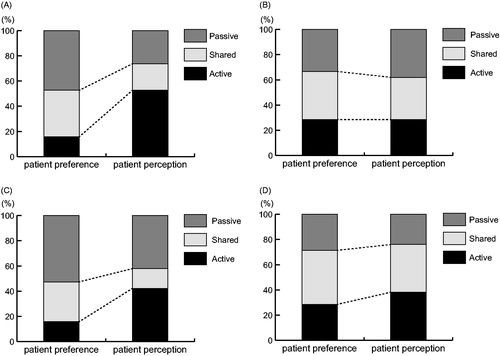Figures & data
Table 1. Patient preferences and perceptions, and physician perceptions.
Figure 1. Association between Hospital Anxiety and Depression Scale (HADS) scores and the change in patients’ preferences and perceptions of their role in the treatment decision. The 40 patients were divided into those with low (A) and high (B) depression scores with a cut-off value of 6, the median score. They were also subclassified as those with low (C) and high (D) anxiety scores with the median score of 4 as the cut-off value. (A) Low consistency between patient preferences and perceptions in 19 patients with low depression scores. The number of patients who perceived that they played an active role increased from three (16%) to 10 (53%) before and after providing informed consent, respectively. (B) High consistencyu in 21 patients with high depression scores, with six (29%) patients perceiving that they played an active role before and after providing informed consent. (C) Low consistency in 19 patients with low anxiety scores, with the number of patients perceiving that they played an active role increasing from three (16%) to eight (42%) before and after providing informed consent, respectively. (D) High consistency in 21 patients with high anxiety scores, with six (29%) and eight (38%) patients perceiving that they played an active role before and after providing informed consent, respectively.

